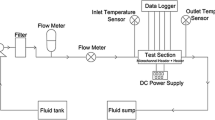Abstract
The high heat flux from electronic devices such as projectors, LEDs, or high power chips requires effective cooling methods at heat dissipation in a limited space. In the present study, the heat and fluid flow characteristics of isothermally heated objects located in a duct were numerically analyzed in order to investigate cooling of electronic devices. The channel had three objects attached to its bottom wall. The numerical computations were performed by solving two-dimensional steady laminar governing equations using the Fluent 17.0 program. Air moving with uniform velocity was taken as the cooling working fluid in the duct. A triangular arc shaped cross-section part was used as a control element. The top and bottom walls of the duct and the part were adiabatic. The part was located at three different points in the y-direction, and these parameters were tested at three different Reynolds numbers (\(150\le \mathrm{Re} \le 600\)). The results were also compared with a non-triangular arc shaped case. The results show that insertion of a triangular arc shaped cross-section part increased the heat transfer for all the Reynolds numbers and the best heat transfer was observed for the part position with y = 1.75 H.
Similar content being viewed by others
REFERENCES
Bergles, A.E., Recent Developments in Enhanced Heat Transfer, Heat Mass Transfer, 2011, vol. 47, pp. 1001–1008.
Webb, R., Principles of Enhanced Heat Transfer, New York: Wiley, 1994.
Incropera, F.P., Convection Heat Transfer in Electronic Equipment Cooling, J. Heat Transfer, 1988, vol. 110, pp. 1097–1111.
Koca, A., Oztop, H.F., and Varol, Y., Natural Convection Analysis for Both Protruding and Flush-Mounted Heaters Located in Triangular Enclosure, Proc. Inst. Mech. Eng. Part C, J. Mech. Eng. Sci., 2008, vol. 222, pp.1203–1214.
Abbassi, H., Turki, S., and Ben Nasrallah, S., Numerical Investigation of Forced Convection in a Plane Channel with a Built-In Triangular Prism, Int. J. Therm. Sci., 2001, vol. 40, pp. 649–658.
Wu, H.W. and Perng, S.W., Effect of an Oblique Plate on the Heat Transfer Enhancement of Mixed Convection over Heated Blocks in a Horizontal Channel, Int. J. Heat Mass Transfer, 1999, vol. 42, pp. 1217–1235.
Valencia, A., Heat Transfer Enhancement due to Self-Sustained Oscillating Transverse Vortices in Channels with Periodically Mounted Rectangular Bars, Int. J. Heat Mass Transfer, 1998, vol. 42, pp. 2053–2062.
Oztop, H.F., Varol, Y., and Alnak, D.E., Control of Heat Transfer and Fluid Flow using a Triangular Bar in Heated Blocks Located in a Channel, Int. Commun. Heat Mass Transfer, 2009, vol. 36, pp. 878–885.
Lorenzini-Gutierrez, D., Hernandez-Guerrero, A., Luviano-Ortiz, J.L., and Leon-Conejo, J.C., Numerical and Experimental Analysis of Heat Transfer Enhancement in a Grooved Channel with Curved Flow Deflectors, Appl. Therm. Eng., 2015, vol. 75, pp. 800–808.
Das, D., Dwivedi, A., and Verma, S.P., Performance of Heated Pin Fin Arrangement in a Rectangular Cavity—An Experimental Approach, J. Mech. Sci. Technol., 2018, vol. 32, pp. 1897–1903.
Alam, T., Saini, R.P., and Saini, J.S., Effect of Circularity of Perforation Holes in V-Shaped Blockages on Heat Transfer and Friction Characteristics of Rectangular Solar Air Heater Duct, Energy Convers. Manag., 2014, vol. 86, pp. 952–963.
Herman, C. and Kang, E., Heat Transfer Enhancement in a Grooved Channel with Curved Vanes, Int. J. Heat Mass Transfer, 2002, vol. 45, pp. 3741–3757.
Sharma, S.K. and Kalamkar, V.R., Computational Fluid Dynamics Approach in Thermo-Hydraulic Analysis of Flow in Ducts with Rib Roughened Walls—A Review, Renew. Sustain. Energy Rev., 2016, vol. 55, pp. 756–788.
Sohankar, A. and Davidson, L., Effect of Inclined Vortex Generators on Heat Transfer Enhancement in a Three-Dimensional Channel, Numer. Heat Transfer, Part A, Appl., 2001, vol. 39, pp. 433–448.
Alahyari Beig, S., Mirzakhalili, E., and Kowsari, F., Investigation of Optimal Position of a Vortex Generator in a Blocked Channel for Heat Transfer Enhancement of Electronic Chips, Int. J. Heat Mass Transfer, 2011, vol. 54, pp. 4317–4324.
Yang, S.J., Numerical Study of Heat Transfer Enhancement in a Channel Flow Using an Oscillating Vortex Generator, Heat Mass Transfer, 2002, vol. 39, pp. 257–265.
Myrum, T.A., Qiu, X., and Acharya, S., Heat Transfer Enhancement in a Ribbed Duct Using Vortex Generators, Int. J. Heat Mass Transfer, 1993, vol. 36, pp. 3497–3508.
Sripattanapipat, S. and Promvonge, P., Numerical Analysis of Laminar Heat Transfer in a Channel with Diamond-Shaped Baffles, Int. Comm. Heat Mass Transfer, 2009, vol. 36, pp. 32–38.
Garimella, S.V. and Eibeck, P.A., Enhancement of Single Phase Convective Heat Transfer from Protruding Elements Using Vortex Generators, Int. J. Heat Mass Transfer, 1991, vol. 34, pp. 2431–2433.
Tsay, Y.L., Cheng, J.C., and Chang, T.S., Enhancement of Heat Transfer from Surface-Mounted Block Heat Sources in a Duct with Baffles, Numer. Heat Transfer, Part A, Appl., 2003, vol. 43, pp. 827–841.
Schmidt, R., Challenges in Electronic Cooling-Opportunities for Enhanced Thermal Management Techniques-Microprocessor Liquid Cooled Minichannel Heat Sink, Heat Transfer Eng., 2004, vol. 25, pp. 3–12.
Dogan, A., Sivrioglu, M., and Baskaya, S., Experimental Investigation of Mixed Convection Heat Transfer in a Rectangular Channel with Discrete Heat Sources at the Top and at the Bottom, Int. Comm. Heat Mass Transfer, 2005, vol. 32, pp. 1244–1252.
Icoz, T. and Jaluria, Y., Design Optimization of Size and Geometry of Vortex Promoter in a Two-Dimensional Channel, J. Heat Transfer, 2006, vol. 128, pp. 1081–1092.
FLUENT, Fluent 6.1 User’s Guide, 2003.
Santra, A.K., Sen, S., and Chakraborty, N., Study of Heat Transfer due to Laminar Flow of Copper-Water Nanofluid through Two Isothermally Heated Parallel Plates, Int. J. Therm. Sci., 2009, vol. 48, pp. 391–400.
Durst, F., Ray, S., Unsal, B., and Bayoumi, O.A., The Development Lengths of Laminar Pipe and Channel Flows, J. Fluids Eng., 2005, vol. 127, pp. 1154–1160.
Author information
Authors and Affiliations
Corresponding authors
Rights and permissions
About this article
Cite this article
Alnak, D.E., Karabulut, K. Effect of Arc Shaped Bar on Heat Transfer and Fluid Characteristics at Cooling of Electronic Equipment. J. Engin. Thermophys. 29, 657–673 (2020). https://doi.org/10.1134/S1810232820040128
Received:
Revised:
Accepted:
Published:
Issue Date:
DOI: https://doi.org/10.1134/S1810232820040128




